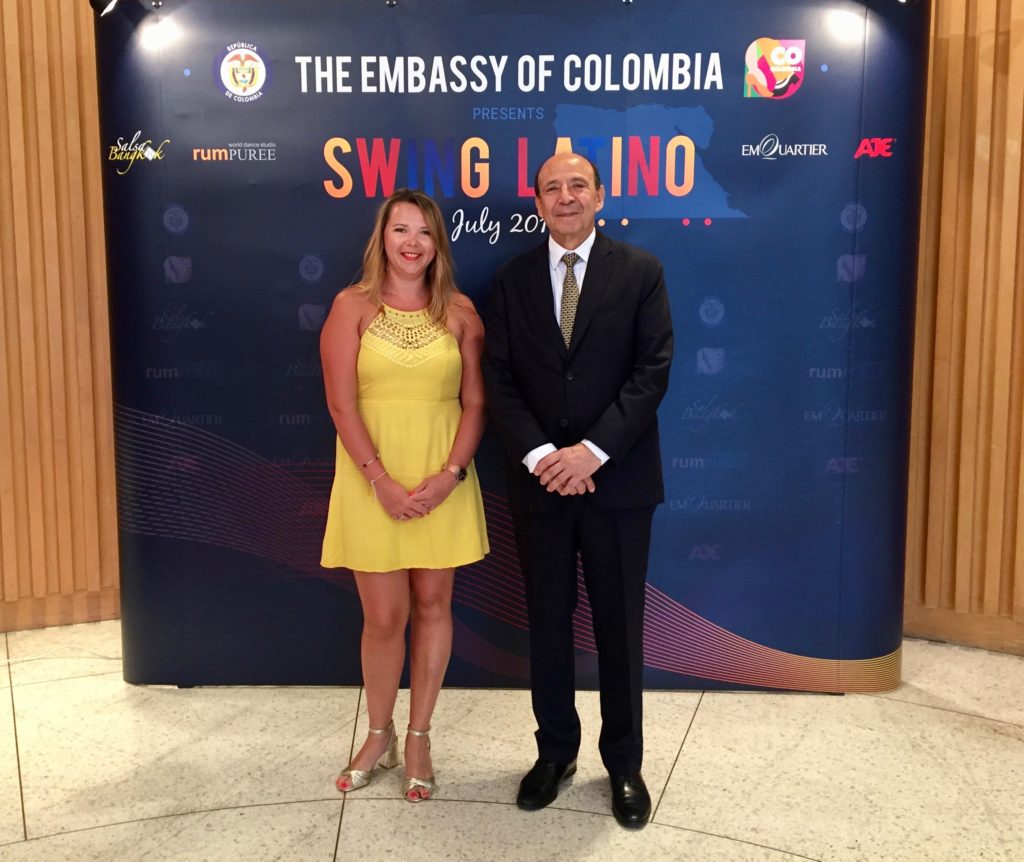
For the past seven years, the Embassy of Colombia to Thailand has been celebrating the country’s independence every July by promoting Colombia’s cultural traditions and showcasing its talent. This year was no exception, bringing Swing Latino, a world champion dance troupe, to Bangkok from 12-14 July 2018 for a special performance and public workshop that took dance diplomacy to another level through Colombia’s unique force, energy and joy.
Colombia and Thailand stand at polar opposite sides of the planet. What can they learn from each other, and how can salsa promote better understanding between these two countries?
According to Colombia’s Ambassador to Thailand Andelfo García, the annual celebrations form part of Colombia’s cultural and sports diplomacy initiative, which is a way of bringing an amiable image of Colombia to be shared with other cultures: “I believe that music is a universal language, especially rhythms like salsa that are already globally renowned and popular, including in Asia. Music brings out the best in of all of us, without a doubt.”
Held at the Bangkok Arts and Culture Centre (BACC), Swing Latino gave an explosive performance that took the audience on a colourful journey through Colombia’s dance history. As I entered the BACC’s auditorium, filled with ambassadors, culture experts, and the local Colombian and dance communities, I took a seat next to a diplomat from one of the Balkan countries who asked me who Swing Latino were. “Just you wait,” I told her. Countless spins, lifts, and speedy steps later, she turned to look at me at the intermission in sheer disbelief.
For Ambassador García, “[dance] is perhaps the most direct form of transmitting values and energy that can connect people with one another. The best form of diplomacy is cultural and sports diplomacy – it’s less restrictive, more free and more friendly.”
What made the celebrations especially friendly and inclusive was a free and public workshop by Swing Latino held in the Helix Garden at EmQuartier just two days later. Organized by the Embassy of Colombia in collaboration with Rumpuree -World Dance Studio, it was open to everyone, allowing the public to participate and be actively engaged in Colombian culture by learning Cali-style salsa, a style which is rarely taught outside of Colombia.
Filled with members of Bangkok’s salsa community as well as Colombians living in Thailand, the group gave lessons for two levels, beginner and intermediate. But beyond giving a standard dance class, it was their energy that created an atmosphere that the Bangkok shopping mall had perhaps never witnessed before, ending the workshop with a dance-off before the dancers went on to spin and flip through the air, taking members of the audience to dance with them in what ended up resembling a vibrant Colombian party in the middle of a Saturday afternoon.
Hailing from Santiago de Cali, Colombia’s third largest city known as the world capital of salsa, Swing Latino have won multiple awards and came in third place at the 2017 World of Dance show. I asked them how they feel representing Colombia at the other side of the world.
“For us, more than anything, it’s our responsibility to represent our country and bring with us a little bit of what Colombia is,” says Melliso, one of the dancers of the group. “Because Colombia, beyond culture, is force, energy and drive. We feel so happy every time we get to share this with a new country.”

Ambassador García believes that dance is a way of representing Colombia in a positive way, with diversity as its strength: “the diversity of dances in Colombia is reflective of the great diversity of Colombia as a country.”
As it emerges from its violent past, dance could indeed form a central part of Colombia’s cultural diplomacy in its capacity to bring a message of peace, happiness and human connection. Two years after receiving the Nobel Peace Prize in 2016, with growing uncertainty of the country’s future, dance offers a unique opportunity, both at home and abroad, for Colombia to bring people together.
Through these events, the Colombian Embassy to Thailand has succeeded in bringing their culture to different audiences –both by showcasing talent but also by letting people be part of it through teaching Cali-style salsa at a more accessible level. When they think of Colombia in the future, they won’t be thinking of a Netflix series, they’ll be thinking of dance.
Dance Diplomacy is not a new concept, and was better known as a tool of peaceful exchange (or propaganda) during the Cold War when the US would send its leading contemporary dance troupes to tour Russia, and Russia would send its best ballet dancers to the stages of New York and London to promote their cultural superiority.
Decades later, Bailando Journey aims to bring dance diplomacy to the digital era by discovering cultures through dance. Specialized in Latin rhythms and styles, it shares the stories of the people and places behind each dance, following the journey of its founder Aliénor Salmon as she dances her way across the world to discover local artists, venues, schools and events. She believes that if you want to understand people, dance their dance. By learning the dances of others, you will be truly living their culture and exploring their country – with your feet and with your heart.
A post shared by Bailando Journey (@bailandojourney) on
Bailando Journey will be dedicating its July newsletter to Colombia!
Like, follow, or sign up for exclusive coverage of Swing Latino’s tour in Bangkok, special articles and interviews, and my experience dancing around Colombia with Santo Baile, Fundación Escuela de Baile Combinación Rumbera, local people and much more! You can sign up for all content in July’s newsletter here.

Behind every dance, there is a story. This book will take you dancing from New York to Buenos Aires, immersing you in the local culture, history, and happiness with every dance step. Aliénor Salmon is represented by Gregory Messina of the Linwood Messina Literary Agency.